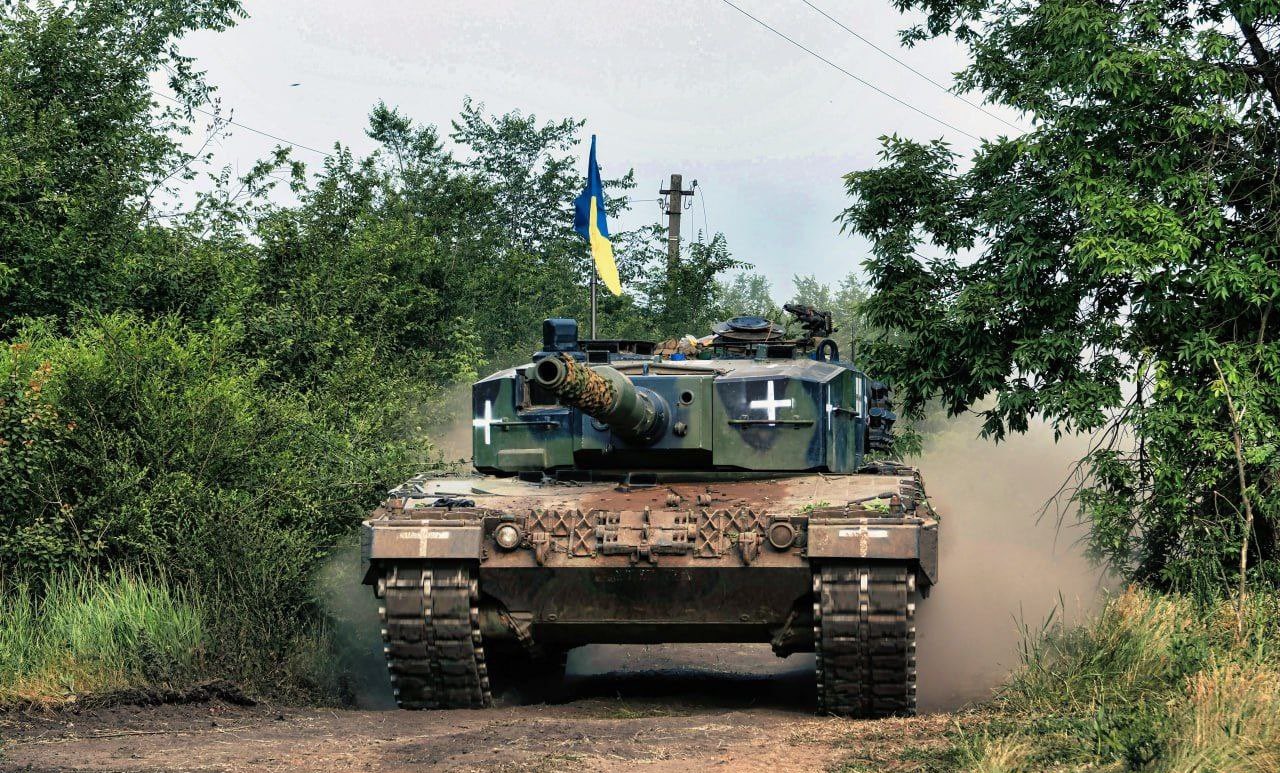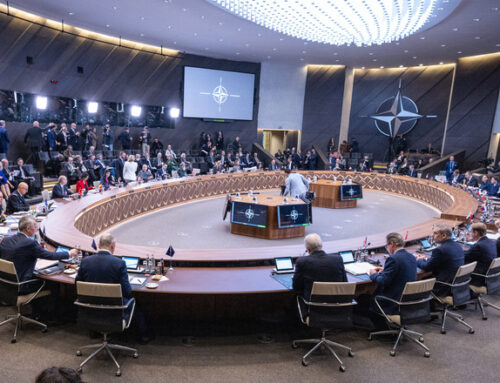Leopard 2 UA
Autor foto: Domena publiczna



Leopard 2 UA
Autor foto: Domena publiczna
War in Ukraine – weekly update (03.06-09.06.2023)
Autor: Sebastian Czub
Opublikowano: 9 czerwca, 2023
Ukrainian Counter Offensive
The long awaited Ukrainian counter offensive has finally begun. Ukrainian forces went on the attack sometime on June 7 in several areas along the line of contact stretching along the entire Zaporizhia Oblast and Donetsk Oblast up to Bakhmut. The ongoing attacks are smaller in scale, quite possibly reinforced recon elements meant to probe Russian defences. However, it is also possible that some of these attacks are small spearheads meant to create breakthroughs in Russian lines that will be exploited by larger ready for action reserves. Such a case might have been observed in the area of the settlement of Mala Tokmachka in Zaporizhia Oblast, where a Ukrainian armoured column, equipped with Leopard 2 tanks assaulted Russian positions.[i] The attack seems to have failed as the Western donated tanks have met heavy artillery fire, with one of the Leopards being destroyed by the bombardment – a first such documented loss of the war.[ii] According to some sources Ukrainian forces are using NATO trained forces equipped with western gear as the “tip of the spear” aim to break through Russian defensive lines.[iii] These combined reports suggest that the initial Ukrainian attacks were at least in some cases meant as breakthrough spearheads, rather than combat reconnaissance.
Worth noting here is as well are the first “official” casualty counts, as the Ukrainian armed forces have entered an information blackout only the Russian sources provide any information in this regard. According to Russian Defence Minister Shoigu during combat operations since the start of the offensive, Ukrainian forces lost 3,715 soldiers, 52 tanks and 207 armoured combat vehicles, with additional 945 soldiers, 33 tanks, 28 infantry fighting vehicles, and 38 armoured fighting vehicles lost on June 7.[iv] While Russian sources have the tendency to overestimate Ukrainian casualties, high casualty counts during the opening day of the offensive coupled with direct assault on Russian fortified positions would result in high losses. Furthermore, a number of footages has become available showcasing at least some of the losses suffered by Ukrainian forces during the assaults. It is also worth remembering that the offensive will result in increased Ukrainian casualty counts.
The following paragraphs aim to describe the situation in the most important areas of the frontline.
Southern Front
Artillery strikes continue along the contact line in Zaporizhia Oblast targeting key targets including road junctions, bridges, supply depots and defensive positions. Ukrainian forces conducted offensive operations in several places along the southern front including Novodarivka, Rivnopil, and Neskuchne – fighting is ongoing. In Avdiivka Ukrainian forces launched an assault on the settlement of Opytne. If Opytne is taken, it could force Russian troops to withdraw from Vodiane, thus opening the way for Ukrainians to enter the Donetsk City airport. Ukrainian forces have also begun offensive operations in the area of Vuhledar, the scale of the fighting and the objectives are unknown, but some sources state that as much as 4 Ukrainian battalions took part in the attack.[v] Further attacks have been launched in the Vuhledar area with a mechanised detachment assaulting Russian positions in the areas surrounding the settlement. The attack was stopped by a Russian minefield and artillery fire which destroyed several Ukrainian armoured vehicles.
Ukrainian forces have also mounted a significant attack in the direction of Robotyne (western Zaporizhia oblast). As mentioned earlier in this area a Ukrainian armoured column was heavily targeted by Russian artillery, with at least 1 Leopard 2 tank destroyed. However, according to some reports Ukrainian forces have managed to break through the initial Russian defences and reached the settlement of Robotyne – fierce fighting is supposedly taking place. During one of the battles however, Russian forces managed to retake the settlement of Novodonetske in Zaporizhia Oblast. The increasing engagement of both sides, now including significant ground attacks, and the commitment of vast amounts of manpower and equipment, including valuable western gear like the Leopard 2 tanks, as well as unprecedented artillery bombardment along the entire frontline, suggest that the Southern Front might turn out to be a new focal point of the war, and possibly the main avenue of the Ukrainian counteroffensive.
Bakhmut
Ukrainian forces carry out offensive operations in the Bakhmut area as part of the spring counter offensive. Ukrainians have managed to regain their initiative around Bakhmut and have launched further attacks against Russian held positions. The fighting is ongoing on the strategic hills west of the settlement of Klishchiivka, however as of the latest information Ukrainian forces have failed to achieve significant results. According to Russian milbloggers Spetsnaz has been deployed in the area to prevent a Ukrainian breakthrough.[vi] To the northwest of Bakhmut, however, Ukrainian forces have achieved noticeable gains. Ukrainians have launched an assault targeting the settlement of Berkhivka, situated north of Bakhmut around the key E-40 highway. The attack was quite successful as Ukrainian forces managed to break through Russian lines and reached the outskirts of Berkhivka. This attack effectively drove a wedge between Russian forces in Bakhmut, and those to the northwest holding the E-40 highway. The attack might compromise these positions by interdicting Russian supply, reinforcement and evacuation routes, especially to the Russian held town of Dubovo-Vasylivka. However, some reports state that the Ukrainian assault is facing stiff resistance and the quite considerable Ukrainian gains come at a steep price, with one US official stating that the casualties are “significant”.[vii]
Currently it seems that it is the Ukrainians that hold the initiative in the Bakhmut area, however if the Russian resistance is maintained the offensive in this area may stall. While Bakhmut may not be the main direction of the Ukrainian offensive, high losses and lack of significant progress in this area may hamper Ukrainian operations elsewhere – allowing Russians to transition local troops onto other key battlefields or forcing Ukrainians to redirect additional manpower and resources to maintain this frontline. If successful the operation around Bakhmut could heavily cripple Russian military capabilities and facilitate Ukrainian operation in other sectors.
The Destruction of the Nova Kakhovka Dam
Russian forces have blown up the great dam on the Dnieper in Nova Kakhovka. The Ukrainian Ministry of Defence accused Russia of using explosives to demolish the dam, resulting in a major ecological and humanitarian disaster. The destruction of the hydroelectric plant led to an unleashing of a wave that flooded vast areas of the Kherson Oblast. The flood affected areas both on the western (Ukrainian held) and eastern (Russian held) banks of the river. Many villages, towns, and even Kherson city itself have been flooded. The destruction of the dam will also result in major issues with potable water supplies for the Crimean Peninsula as the Nova Kakhovka reservoir provided the majority of the water. Even now, reports from Crimea state that there are problems with the access to drinkable water, stating that available water is contaminated and not suitable for use. The flood wave also destroyed the positions of armed forces of both sides, with RUssia losing its first line of defence on the eastern bank of the Dnieper river. There remains only one question: why would Russia blow up the dam?
The destruction of the Nova Kakhovka dam by the Russian forces has been widely speculated about since the onset of the Ukrainian counteroffensive in the fall of 2022. The previous discussions often concluded that Russian losses in the aftermath of the dam destruction would be higher than the potential gains. However, now after the destruction of the dam it is worth to consider what might have pushed the Russian forces to such an extreme move and what they hope to gain from it.
The first major gain is the complete postponement of Ukrainian offensive operations in the area. The flood wave is set to last for around 10 to 12 days, with the areas affected needing as much as 5 weeks to dry up and return to pre flooding conditions.[viii] This means that any Ukrainian operations in the area, for example as part of the Ukrainian counter offensive, won’t be possible for the next 6 – 7 weeks, ergo middle of July. On the other hand the flooding also destroyed Russian defensive positions comprising their first line of defence on the eastern bank, meaning that if Ukrainians choose to attack there, after the flood ends, they would be initially unopposed. There are reports that state that Russian forces have withdrawn their forces and equipment to the second line of defence, unaffected by the flooding. It is possible that Russian forces decided that limited initial gains of a possible Ukrainian assault across the river are acceptable and that the second line would be sufficient in dealing with the attack. The other option is that the Russians will aim to reoccupy the currently inaccessible areas as the flood dissipates.
Secondly, the postponement of Ukrainian operations along the Kherson line would allow Russian forces to transition troops to more contested areas of the battlefield. As the Ukrainians will be unable to conduct offensive operations in the area for the next several weeks, this allows Russians to safely relocate troops to other key fronts, for example Bakhmut, while leaving behind only placeholder forces. This in turn might potentially allow the Russians to retake initiative in other sections of the front or thwart the upcoming Ukrainian counteroffensive.
Thirdly, the destruction of Khakovka might destabilise the Ukrainian war effort by the creation of a humanitarian disaster. The flooding of the Kherson Oblast has already forced Ukraine to invest vast amounts of manpower and resources to save the life of affected people, and mitigate damage. These resources will have to be continuously committed in order to manage the affected areas. Even after the flood has ended manpower and resources will have to be invested to rebuild and repair, especially of strategic targets, like power plants, transportation systems and facilities for the population. At the same time provisions will have to be made for the affected populace – temporary housing, food, water, and other first need supplies, and medical care. The last almost 16 months of full scale war have made Ukraine quite proficient in crisis management, thus Ukraine will be able to tackle these challenges. However, it will take away crucial resources and manpower, as well as attention, that might be needed on the frontlines. Furthermore, the destruction of the dam will have long term consequences as the Nova Kakhovka reservoir provides water for 94% of irrigation systems in Kherson Oblast, 74% in Zaporizhia Oblast, and 30% in Dnipropetrovsk Oblast.[ix] This might lead to vast failure of crop yields, from the bountiful Ukrainian farmlands that provide key food products. This might force Ukraine to commit further resources and manpower to resolve this issue, as otherwise the country, as well as other nations reliant on Ukraine for food might be faced with a bleak prospect of famine. This might hamper Ukrainian war effort, and potentially compromise the counter offensive.
Conclusion
As the Ukrainian counter offensive begins in earnest, and thousands of troops go onto the attack armed with western gear and Russian forces mobilise en masse to respond to the attack one can safely state that a key point in the war for Ukraine has come and it very well be the war’s make or break.
Author: Sebastian Czub, Analyst Casimir Pulaski Foundation
[i] GeoConfirmed, Twitter, June 8, 2023, https://twitter.com/geoconfirmed/status/1666743576678522885?s=46&t=I-r9GETvDy8gm6bbbhswvA.
[ii] Ukraine Weapons Tracker, Twitter, June 8, 2023,
https://twitter.com/uaweapons/status/1666830782533435394?s=46&t=I-r9GETvDy8gm6bbbhswvA.
[iii] Samantha Schmidt et al., “Ukraine launches counteroffensive against Russia”, The Washington Post, June 9, 2023, https://www.washingtonpost.com/world/2023/06/08/russia-ukraine-war-news-counteroffensive/.
[iv] “Kiev’s offensive fails; what’s behind Kakhovka dam strike — details from Shoigu”, TASS Russian News Agency, June 6, 2023, https://tass.com/defense/1628609.
Bartłomiej Wypartowicz, Twitter, June 8, 2023, https://twitter.com/wypartowiczba/status/1666794423152259072?s=46&t=I-r9GETvDy8gm6bbbhswvA.
[v] Artur Micek, Twitter, June 7, 2023, https://twitter.com/Artur_Micek/status/1666219863101124611.
[vi] Karolina Hird et al., “Russian Offensive Campaign Assessment, June 6, 2023”, Press ISW, June 6, 2023, https://www.understandingwar.org/backgrounder/russian-offensive-campaign-assessment-june-6-2023.
[vii] Jim Sciutto, “Ukrainian forces suffer ‘stiff resistance’ and losses in assault on Russian lines”, CNN, June 8, 2023, https://edition.cnn.com/2023/06/08/politics/ukraine-forces-resistance/index.html.
[viii] Artur Micek, Twitter, June 7, 2023, https://twitter.com/Artur_Micek/status/1666219863101124611.
[ix] Tatarigami_UA, Twitter, June 6, 2023, https://twitter.com/Tatarigami_UA/status/1666174186685956099?cxt=HHwWhoC8tYqmuJ8uAAAA.






